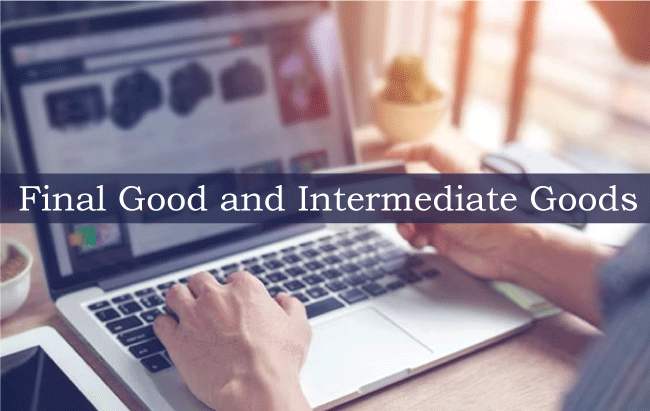Difference Between Final Goods and Intermediate GoodsIn the modern economies, there are two distinct categories of goods used in the production and also for the consumption of goods and services, these two distinct categories of goods are- Final Goods and Intermediate Goods. It is vital to understand the difference between these two goods especially if you have businesses, or even if you are a economist, or a policymaker. It is said like that because knowing the difference between the two will have certain important implications for economic growth, productivity, and on inflation as well! 
In this article, we will briefly discuss the differences between intermediate goods and final goods, we will focus on their definitions, characteristics, and on their uses. Further, we will also provide you with a difference table which will help you summarize the key differences between intermediate goods and final goods. Definitions of Final Goods and Intermediate GoodsFinal goods are also known as finished goods. Final goods are basically the products that are absolutely ready to be consumed or can be used by the final user. To put it simply, final goods are the end result of the production process and are sold in the market to satisfy the requirement or need of the customer. Here are the few examples of final goods- clothes, electronics, furniture, automobiles, and food. On the other hand, intermediate goods are products that are used as inputs in the production of other goods as well as for the services. Intermediate goods are not sold to the customer but are used in the process of making the final good that is sold to the customer. Here are a few examples of Intermediate goods- raw material, semi-finished goods, components, and parts. 
Characteristics of Final Goods and Intermediate GoodsThe major difference which you can find between Intermediate and final goods is their characteristics, which eventually reflect their roles in production and also on their consumption process. Here are some of the key characteristics of final goods and intermediate goods: A. Consumption Final goods are consumed by the consumer, on the other hand, intermediate goods are used in the production process. B. Value-Added Final goods have their value through the production process, on the other hand intermediate goods contribute to the value-added of the final good. C. Quality Final goods need to have a good quality to satisfy the customer, on the other hand, intermediate goods are to be of good quality to create a fine final good to promote the business. D. Price Final goods are sold at a higher price to the customer. Intermediate goods have price only for the business that too as a vital raw material. E. Inventory Final goods are held in the inventory by the retailer, on the other hand, intermediate goods are held in the inventory by the manufacturers. Uses of Final Goods and Intermediate GoodsDue to their different roles in the economy, final goods and intermediate goods are used in different ways by the business owners and also by the consumers. Some of the uses of final goods are intermediate goods are as follow: Production Intermediate goods are used in the production process by the business owners to create a good quality final goods. Let us have a look at the example to understand the concept in a better way: Steel is an intermediate good and is used in the production of automobiles which is the final good. Consumption Final goods are consumed by the consumer directly to satisfy its own needs. Here is an example- Flour is the intermediate good used by the biscuit factory to create good quality biscuits (final good) that is enjoyed by the customer. Investment Both final goods and intermediate goods can be used as investments. Final goods cab be investments only in the hope of appreciation or rental income by the customers, on the other hand, intermediate goods are an investment in the hope of capital gains or to hedge against future price increases. Trade Final goods are traded between the countries as a part of international trade of certain businesses, on the other hand, intermediate goods are traded but are less visible in international trade statistics. Difference TableHere is the difference table that will help you summarize the main criteria that distinguish final goods from intermediate goods:
The table summarizes the main differences between intermediate and final goods. 1. Definition Final goods are the goods that are the end result of the intermediate goods that are used in the production process. 2. Consumption Final goods are consumed by the consumer who is the end user, on the other hand, intermediate goods are used in the production process to create a good quality final good. 3. Value-Added The value of final goods are added in their production process, while intermediate goods contribute to the value-added of the final goods. Value-added is a process that refers to the increase in value that occurs at each stage of the production process. Quality Final goods are produced to meet the consumer demands for quality, intermediate goods are produced to meet the quality of the production needs of their businesses. Price The price of the Final good is indeed hire than the price of the intermediate goods, reflecting the value-added in the production process. The price of final goods is showcased on the price of production, distribution, and marketing as well. On the other hand, the price of intermediate goods reflect their role as inputs in the production process. Inventory Reflectors are their to keep the inventory of final goods, on the other hand manufacturers hold the inventory of intermediate goods. Retailers hold inventory to meet the consumer goods, in case of intermediate goods manufacturers hold the inventory to ensure a steady supply of inputs for production. Uses Final goods are mainly used in the production, consumption, and investments, on the other hand, intermediate goods are used in the production and trade process only. Final goods are used by the end user for their personal enjoyment r use as well, used as inputs in the production of other goods and services, or are purchased as investments. On the other hand, intermediate goods are not sold directly to the customers but rather are used as inputs in the production process of other goods and services or are traded between the businesses. ConclusionFinal goods and intermediate goods are the most important concepts which are considered in the field of economics. The sole reason behind this is that both these goods play a vital role in the production as well as in the consumption of goods and services in the modern economic times. It is vital to understand the difference between these two goods as both these goods are essential for businesses- they help in production, maintaining the quality, and it also leaves an impression on the costumer. It is also important for the policymakers, and consumers, to know the difference between these goods as it has a massive impact on the economic growth, productivity, and on the inflation as well. Overall, the key criteria that creates a difference between the final goods and intermediate goods are their consumption, value-added, quality, price, inventory, and uses. Understanding these major differences is important for business owners who are involved in the production process and for those as well who create final goods, not only for the business but it is also important for the policymakers as it helps them make a decision related to the production, pricing, and trade.
Next TopicDifference between
|
 For Videos Join Our Youtube Channel: Join Now
For Videos Join Our Youtube Channel: Join Now
Feedback
- Send your Feedback to [email protected]
Help Others, Please Share










